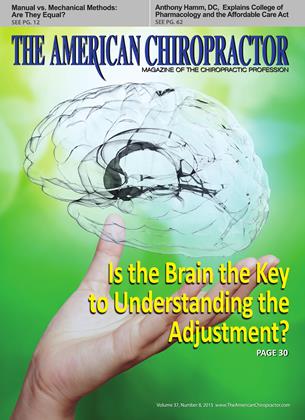Increased Referrals by Solving Problem Cases
TECHNIQUE
Howard F. Loomis
I have been advocating an examination approach that recognizes that muscle contraction accompanied inevitably with loss of range of motion can be caused not only by a structural problem but by visceral function as well. In other words, they should not be separated when we attempt to establish the cause of chronic, recurring subluxation patterns. Those of you who have been reading my articles for years know that I believe that chiropractors are the only healers who have been trained to simultaneously integrate the anatomy, physiology, and neurology involved with a patient’s symptoms before making a treatment plan. To conclude a treatment plan successfully, you must start by finding the cause.
That brings us to an important consideration: What tests can you perform in your office that other practitioners do not? Unfortunately, I have found that most chiropractors do not include a periodic postural screening of their patients. What better way to begin screening for muscle contraction and then find its cause? A visual inspection only takes about one minute and is one of the most effective means of patient education
^1 have found that most chiropractors do not include a periodic postural screening of their patients. J J
available to you. No expensive equipment is needed, except perhaps a full-length mirror. Once postural deviations are identified and related to their symptoms, patients can recognize when they need to return to your office, and do so before their symptoms return.
The chart below lists the various organs in the body. Each shares spinal innervation with a set of muscles and a specific surface area on the skin. These connections were developed
during the third week of embryonic life from the ectoderm, mesoderm, and endoderm germinal layers and can provide a very accurate diagnostic system when properly employed.
Here is a suggestion that may help you find if a visceral problem is the cause of a patient’s chronic, recurring subluxation pattem. Identify the chronic spinal subluxation and then palpate the muscles that share the innervation for contraction, soreness, and pain. Most of these will be located on the anterior of the body. Next, adjust the spinal innervation. Now repalpate for the anterior contraction(s). If they are gone, the cause was structural, but if they are still present, the cause is visceral. Who else can do that?
As you make your spinal corrections, can you name the effects that each has on the affected organ? Do you attempt to correlate a patient’s symptoms to this chart and then
Sympathetic Organ Parasympathetic Innervation Innervation Tl to T2 Eyes Cranial VII Tl to T2 Salivary Glands Cranial VII Tl to T3 Mucous Membranes Cranial VII of the Head Cranial X T1 Thyroid Cranial X Tl to T6 Heart Cranial X Tl to T7 Lungs and Bronchi Tl to L3 Skin The Cervical Sympathetic Ganglion Superior, middle, and inferior can be involved with all of the above T4 to T8 Biliary System Cranial X T4 toTIO Liver Cranial X T5 to T9 Stomach Cranial X T5 to T9 Pancreas Cranial X T6 to T8 Spleen 7 T9 toTIO Adrenal 7 T9 to LÍ Small Intestine Cranial X TIOtoTll Kidney 7 TIOtoTll Male Sex Glands S2 to S4 TIOtoLl Female Sex Glands S2 to S4 T12 to L2 Urinary Bladder S2 to S4 LÍ Ileocecal Valve Cranial X LÍ to L3 Ascending Colon Cranial X LÍ to L3 Descending Colon S2 to S4
‘ ‘As you make your spinal corrections, can you name the effects that each has on the affected organ? 5 5
palpate within the affected muscles to determine if the cause of the structural subluxation or misalignment came from a visceral stress?
Once learned, this system adds very little time to an office call, but experience has taught that me that it may very well double your referrals and income in a short period of time. That should be worth a small investment of your time. How many of the spinal innervations and autonomic effects have you committed to memory from the following list?
Successful doctors address the cause of the problem, not the symptoms. They aie able to quickly and accurately determine the source of a patient’s stress, devise a plan of treatment, and confidently convey their findings to their patient. They specialize in helping problem cases—the ones that no one else can help. They solve these cases by identifying the specific cause(s) of a patient’s symptoms that have not been identified elsewhere.
I would suggest that you need the following to enhance your practice:
1. An examination that identifies the exact cause of your patients’ symptoms, be it anatomical, physiological, or neurological.
2. Absolute confidence that your examination will stand the light of scientific scrutiny and will yield information quickly and accurately.
3. A ceremony that both educates and inspires your patient. Ceremonies are important and you already have one. It is your office procedure.
Symptoms, muscle contraction patterns, and related structural problems may have become chronic because the underlying visceral dysfunction has not been identified.
Dr. Howard Loomis has an extensive background in enzymes and enzyme supplements. He is the founder and I president of Enzyme Formulations®, Inc. His knowledge of physiology, biochemistry, and enzymology has made him a sought-after speaker and a prolific writer Dr Loomis recently published another book, The Enzyme Ach’antage: For Health Care Providers And People Who Care About Their Health. Contact info: 6421 Enterprise Lane, Madison, WI53719, customerservice(xf loomisinstitute. com, 800-662-2630.
 View Full Issue
View Full Issue






